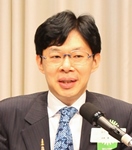Gaining Victory through Unconventional Moves
March 25, 2015
Mr. Koji Tanigawa
Japan Shogi Association
Shogi Player 9-dan
�� I often get asked by shogi (Japanese chess) fans about how far ahead professional shogi players calculate and read the moves. To be honest, this is quite a challenging question. My answer depends on my condition. I may answer ��1,000 moves�� when I am in good form, while my answer will become ��all I can read is 1 move�� when I am not confident.
I often get asked by shogi (Japanese chess) fans about how far ahead professional shogi players calculate and read the moves. To be honest, this is quite a challenging question. My answer depends on my condition. I may answer ��1,000 moves�� when I am in good form, while my answer will become ��all I can read is 1 move�� when I am not confident.
��My answer also varies depending on the question ��how many moves I read�� and ��how many moves ahead I read.�� Please visualize a tree diagram. To answer the latter question, I need to count only the ��trunk�� of the diagram. As one shogi game has about 110 moves on average, reading about 10 moves ahead will be sufficient. To answer the former question, however, I must include multiple branches of variations and options on the diagram. This makes me read 100 moves or even 1,000 moves. You might be surprised or impressed but I must say what is more important for a professional shogi player is to read the perfect next move you are about to make. In a shogi game, two players alternate, moving one piece in each turn. You should therefore concentrate on the very next move after your opponent has made his/her move.
��Professional shogi players attach utmost importance to intuition. Based on their knowledge, experience, senses and originality acquired from previous games, professional shogi players reject almost 90% of options and read the remaining 10% in great depth.
��The initial setup of a shogi board has 20 pieces of koma. Now, do you know how many possible options the first player has? The answer is 30, of which experienced shogi players concentrate on about 3 patterns. Now, your opponent also has 30 options to make in theory and the third move gives a player 900 options (30 multiplied by 30). But as I mentioned, the players concentrate on only about 10 % of the options.
��Shogi players are allowed to redeploy the captured pieces, making it a very unique game in the world. This rule also makes shogi much more complicated and challenging as the game proceeds. If you have many captured pieces, you have a wider variety of options. Shogi players concentrate on about 3 to 5 options they have identified through intuition and deliberate on the best next move for about 30 minutes. There are a few times in a game when you feel stuck. I try to move away from the shogi board, go to the bathroom or look out of the window, re-set myself from the very start of the game and try to look for other good options I might have rejected by intuition.
��To be a professional shogi player, 90% of your intuition must be correct. As we start playing shogi from our early childhood, we know from our long experiences that natural or beautiful moves guarantee perfection. But on rare occasions, the best move can be hiding behind unpleasant or unattractive moves. It goes without saying that professional shogi players study and deliberate on conventional moves. Just doing so, however, is not sufficient to become a top player. You must exert your strong individuality to be the foremost player. You cannot become a professional player unless you understand the right course (conventional), but if you only stick to it, you cannot become the top player.
��I started shogi at the age 5 and have enjoyed it over my 48-year career. The attraction of shogi has varied over the years. I have come to think the real joy of shogi is to find out the unconventional move that proves to be the best. An average shogi game has about 110 moves, which are shared with your opponent. You have 55 moves for yourself, half of which have a clear-cut conventional answer. Therefore, you can exert your individuality over the remaining 30 or so moves. The best unconventional moves can be hiding behind 10% of such moves, thus I have come to find real joy in identifying these 3 moves as a professional player.
��As a Rotarian, you are at the forefront of very successful businesses. I think the world of business and shogi share a common ground. I assume there are some unprecedented, exceptional cases where the conventional business practices would not apply. To overcome such challenges through unconventional moves can be the best part of your business and the victory can bring you real joy.
��Shogi originated in Japan. Thanks to the development of the internet, we are attracting many more fans overseas. The Japan Shogi Association is working to get shogi included in the events of the World Mind Sports Games, scheduled to coincide with the 2020 Tokyo Olympics and Paralympics. When I was a child, I was often told to study, instead of playing shogi. It is welcoming that shogi is now considered to develop children��s memory skills, concentration and decisiveness and it has become one of the extra-curriculum activities. Among shogi tournaments held for children today, the biggest one takes place every November in Tokyo with the participation of over 3,000 children. I always tell children to develop different abilities through shogi and to find what they like by using both their physical and intellectual power.
��Let me close my speech by asking for your continuous support to the world of shogi.